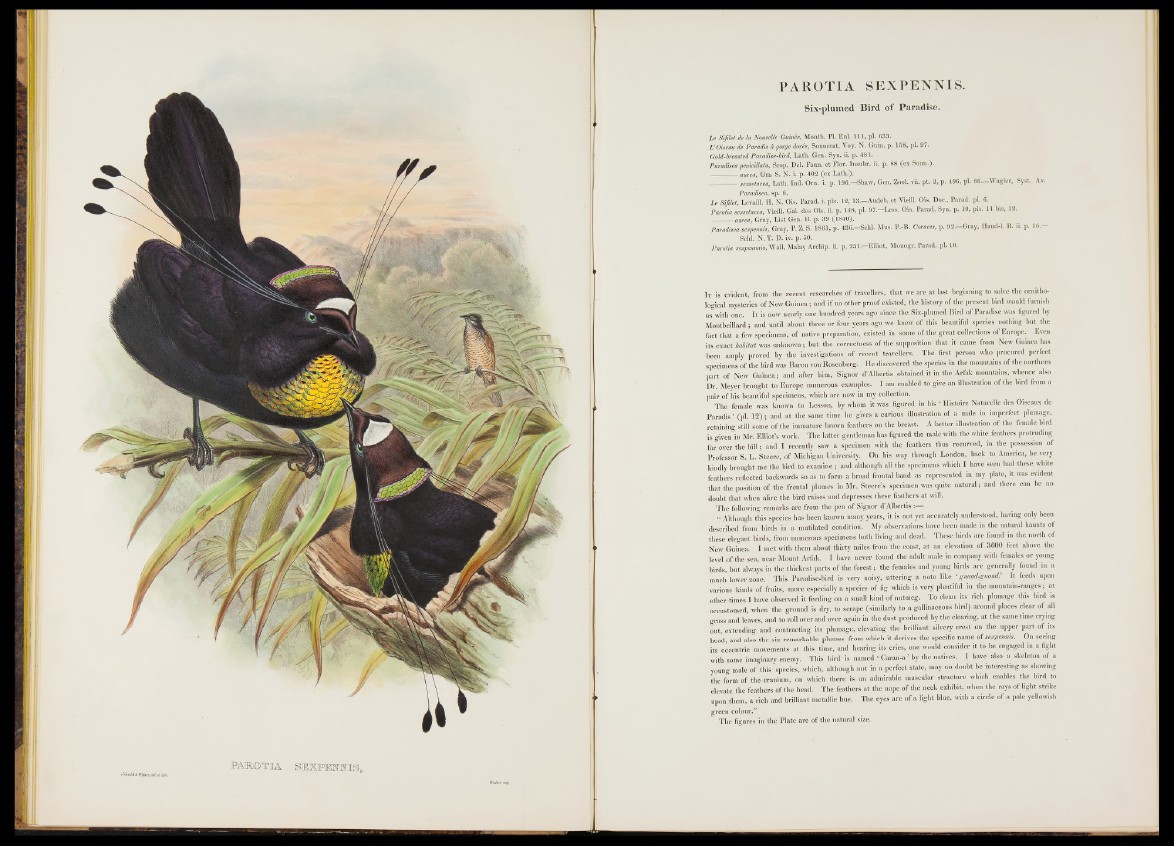
PAROTIA SEXPENNIS .
Six-plumed Bird of Paradise.
Le Sifilet de la Nouvelle Guinée, Montb. PL Enl. 111, pl. 633.
L’Oiseau de Paradis à gorge dorée, Sonnerat, Voy. N . Guixx. p. 158, pl. 97.
Gold-hreasted Paradise-bird, Lath. Gen. Syn. ii. p. 481.
Paradisea penicillata, Scop. Del. Faun. et Flor. Insubr. ii. p. 88 (e x Sonn.).
------------— aurea, Gm. S. N . i. p. 402 (ex Lath.).
setcsetmea, Lath. Ind. O n i. p. 196.—Shaw, Gen. Zool. t u . pt. 2, p. 496, pl. 66.—Wagler, Syst. Av.
Paradisea, sp. 6.
Le Sifilet, Levaill. H. N . Ois. Parad. i. pis. 12, 13.—Audeb. et VieiU. Ois. Dor., Parad. pl. 6.
Parotia semetacea, VieiU. Gai. des Ois. ii. p. 148, pl. 9 7—Less. Ois. Parad. Syn. p. 10, pis. 11 bis, 12.
aurea, Gray, List Gen. B . p. 39 (4 840).
Paradisea seapemis, Gray, P. Z. S. 1861, p . 4 3 6 ,-S chL Mus. P.-B. Coraces, p. 9 2 .-G r a y , Hand-1. B. ii. p. 1 6 . -
.Schl. N . T. D. iv. p. 50.
Parotia seapemnis, WaU. Malay Arohip. ii. p. 251.—Blliot, Monogr. Parad. pl. 10.
It is evident, from the recent researches o f travellers, that we are at last beginning to solve the ornithological
mysteries of New G uinea; and if no other proof existed, the history o f the present bird would famish
as with one. It is now nearly one hundred years ago since the Six-plumed Bird o f Paradise was figured by
Montbeillard; and until about three or four years ago we knew of this beautiful species nothing but the
fact that a few specimens, o f native preparation, existed in some o f the great collections o f Europe. Even
its exact habitat was unknown ; but the correctness of the supposition that it came from New Guinea has
been amply proved by the investigations of recent travellers. The first person who procured perfect
specimens of the bird was Baron von Rosenberg. He discovered the species in the mountains of the northern
part o f New Guinea; and after him, Signor d’Albertis obtained it in the Arfak mountains, whence also
Dr. Meyer brought to Europe numerous examples. I am enabled to give an illustration o f the bird from a
pair o f his beautiful specimens, which are now in my collection.
The female was known to Lesson, by whom it was figured in his ‘ Histoire Naturelle des Oiseaux de
Paradis ’ (pi. 1 2 ) ; and at the same time he gives a curious illustration of a male in imperfect plumage,
retaining still some o f the immature brown feathers on the breast. A better illustration o f the female bird
is given in Mr. Elliot’s work. The latter gentleman has figured the male with the white feathers protruding
for over the b ill; and I recently saw a specimen with the feathers thus recurved, in the possession of
Professor S. L. Steere, of Michigan University. On his way through London, back to America, he very
kindly brought me the bird to examine ; and although all the specimens which I have seen had these white
feathers refiected backwards so as to form a broad frontal band as represented in my plate, it was evident
that the position o f the frontal plumes in Mr. Steere’s specimen was quite natural; and there can be no
doubt that when alive the bird raises and depresses these feathers at t y il^ H
The following remarks are from the pen of Signor d’Albertis :::—
“ Although this species has been known many years, it is not yet accurately understood, having only been
described from birds in a mutilated condition. My observations have been made in the natural haunts of
these elegant birds, from numerous specimens both living ;abd dead. These birds are found in the north of
New Guinea. I met with them about thirty miles from the coast, at an elevation o f 3600 feet above the
level o f the sea, near Mount Arfak. I have never found the adult male in company with females or young
birds, but always in the thickest parts o f the forest; the females and young birds are generally found in a
much lower zone. This Paradise-bird is very noisy, uttering a note like ‘g u a a ig u a a d : It feeds upon
various kinds o f fruits, more especially a species of fig which is very plentiful in the mountain-ranges; at
other times I have observed it feeding on a small kind o f nutmeg. To clean its rich plumage this bird is
accustomed, when the ground is dry, to scrape (similarly to a gallinaceous bird) around places clear o f all
grass and leaves, and to roll over and over again in the dust produced by the clearing, at the same time crying
out, extending, and contracting its plumage, elevating the brilliant silvery crest on the upper part o f its
head, and also the six remarkable plumes from which it derives the specific name o i sexpennis. On seeing
its eccentric movements at this time, and hearing its cries, one would consider it to be engaged in a fight
with some imaginary enemy. This bird is named ‘ Caran-a’ by the natives. I have also a skeleton of a
young male of this species, which, although not in a perfect state, may no doubt be interesting as showing
the form of the cranium, on which there is an admirable muscular structure which enables the bird to
elevate the feathers o f the head. The feathers at the nape o f the neck exhibit, when the rays of light strike
upon them, a rich and brilliant metallic hue. The eyes are o f a light blue, with a circle of a pale yellowish
green colour.”
The figures in the Plate are o f the natural size.